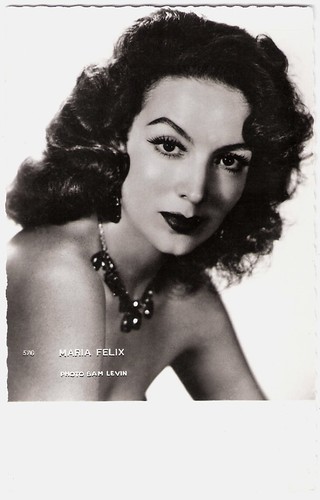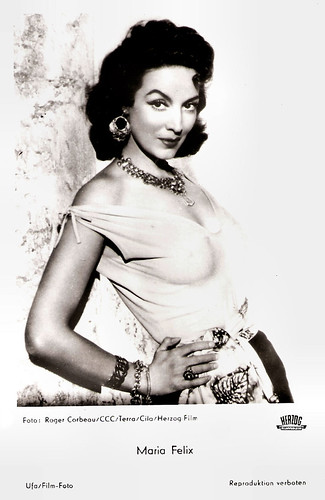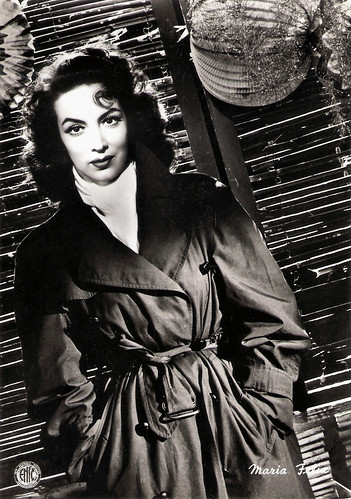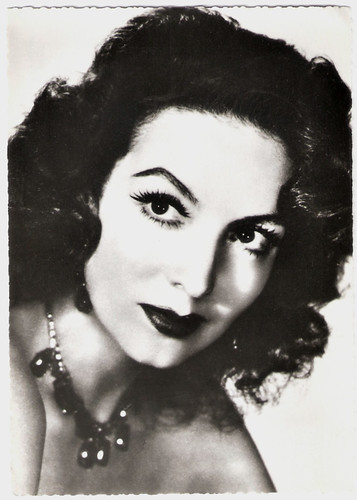Energetic, fiery femme fatale María Félix (1914–2002) was an icon of the Golden Age of Mexican cinema. She was considered one of the most beautiful film actresses of her time, and one of the erotic myths of the Spanish-language cinema. Her career included 47 films in Mexico, Spain, France, Italy and Argentina.

Italian postcard by Bromofoto, Milano, no. 272. Photo: Manderfilm, Roma. Publicity still for Maclovia (Emilio Fernández, 1948).

French postcard by Editions P.I., offered by Les Carbones Korès Carboplane, no. 576. Photo: Sam Lévin.

French postcard by Editions du Globe, Paris, no. 189. Photo: Studio Harcourt.
Maria de los Angeles Felix Güereña was born in Álamos, México in 1914. She was the daughter of Bernardo Félix Flores, military officer and secretary of Hacienda, and Josefina Güereña Rosas. She and her eleven siblings spent her childhood in Álamos. The family lived with dignity, despite not being rich. As a young girl, Maria enjoyed games for boys, was an accomplished horse rider and had a strong personality.
When María was a teenager, her beauty soon began to attract attention. She was crowned Queen of the Beauty at the University of Guadalajara. After a brief romance with Enrique Álvarez Alatorre, a salesman for the cosmetics firm Max Factor, the couple married in 1931. In 1935, María gave birth to her only child, Enrique Quique, but the marriage was unsuccessful and the couple divorced in 1937. After her divorce, María returned to Guadalajara with her family, where she was the subject of gossip and rumours due to her divorcee status.
María decided to move to Mexico City with her son. There she was spotted by film director Fernando Palacios. She was offered the female lead role in El Peñón de las Ánimas/The Rock of Souls (Miguel Zacarías, 1943) opposite the popular Mexican actor and singer Jorge Negrete. The plot is loosely based on the Shakespeare drama Romeo and Juliet, transferred to the early 20th Century rural areas of Mexico. In her second film, Maria Eugenia (Felipe Gregorio Castillo, 1943), María was miscast in a role out of her temperamental film personality.
Maria Felix became known as La Doña for her femme fatale role in Doña Bárbara (Fernando de Fuentes, Miguel M. Delgado, 1943), based on the same name novel of the Venezuelan writer Romulo Gallegos. Doña Barbara tells the story of a Venezuelan woman, raped in her youth, who runs her ranch despotically while dressed in men's clothes and dabbles in witchcraft. To the end of her life, Félix was referred to as Doña Barbara, and her subsequent roles built on the image.
It was also the start of her major collaborations with Mexican film director Fernando de Fuentes. Félix and de Fuentes filmed together another two films: La Mujer sin Alma/Woman Without a Soul (Fernando de Fuentes, 1944) and La Devoradora/Devouring (Fernando de Fuentes, 1946). With these films, María became "the number one enemy of the Mexican family morals". Maria also played out-of-type dramatic roles of great intensity in the sophisticated films El monje blanco/White Monk (Julio Bracho, 1945) and Vértigo/Vertigo (Antonio Momplet, 1946).

German postcard by Ufa, Berlin-Temnpelhof, no. FK 1932. Photo: Roger Corbeau / CCC / Terra / Cila / Herzog-Film. Publicity still for Les héros sont fatigués/Heroes and Sinners (Yves Ciampi, 1955).

Italian postcard by Bromofoto, Milano, no. 1068. Photo: ENIC.

German postcard by Kunst und Bild, Berlin, no. A 405. Photo: Allianz Film. Maria Félix in Messalina (Carmine Gallone, 1951).
Maria Félix made three successful films under the direction of the famous Mexican film director Emilio Fernandez. These were the delightful comedies Enamorada/In Love (1946), Rio Escondido/ Hidden River (1947) and Maclovia (1948). The relationship between María and Fernandez was cordial and smooth, despite the strong and famous temperament of the film director. In Enamorada, María finds her perfect film partner, actor Pedro Armendáriz.
The films of María with Fernandez and his team (writer Mauricio Magdaleno, photographer Gabriel Figueroa and Armendáriz) were successfully shown at several international film festivals. Maria also worked with Roberto Gavaldón, another director who showcased some of her best performances. Their first collaboration was in La diosa arrodillada/The Kneeling Goddess (Roberto Gavaldón, 1947) with Arturo de Córdova.
Thanks to these films, María's became internationally known and she started a second film career in Europe. In 1948 she was contracted by the Spanish film producer Cesreo Gonzalez. María debuted in the European cinema with Mare Nostrum (Rafael Gil, 1948) opposite Fernando Rey. In 1950, she made two more films with Gil, Una mujer cualquiera/Any Woman (Rafael Gil, 1950) with Antonio Vilar, and La noche del sábado/Saturday Night (Rafael Gil, 1950).
Then she filmed the French-Spanish production La Couronne Noire/Black Crown (Luis Saslavsky, 1951) based on a story by Jean Cocteau. She debuted in Italy with Incantesimo Tragico/Tragic Spell (Mario Sequi, 1951) opposite Rossano Brazzi. In the same year, she filmed Messalina (Carmine Gallone, 1951), with Georges Marchal. At the time, it was the most expensive film in the Italian cinema. In Argentina, Maria appeared in La pasión desnuda/Naked Passion (Luis César Amadori, 1952) at the side of Carlos Thompson. She returned to Mexico to film Camelia (Cesáreo González, 1952) and she married her former co-star Jorge Negrete. Together, they filmed El rapto/The Rapture (Emilio Fernández, 1954). It would be the last film of Negrete, who died in December 1953.
After the death of her husband, María returned to Europe. In France, she made the films La Belle Otero (Richard Pottier, 1954), and Les Heros sont Fatigues/The Heroes Are Tired (Yves Ciampi, 1955), alongside Yves Montand. However, her most important film in this period is French Cancan (Jean Renoir, 1954) with the legendary Jean Gabin. It chronicles the revival of Paris' most notorious dance. Her latest film shot entirely in Europe, was the Spanish production Faustina (José Luis Sáenz de Heredia, 1957) with Fernando Fernán-Gómez and Fernando Rey.

Russian postcard. Photo: Unifrance Film.

Yugoslavian postcard by ZK, no. 2064.

Dutch postcard by Gebr. Spanjersberg N.V., Rotterdam, Dutch licency holder for Universum-Film Aktiengesellschaft, Berlin-Templehof, no. 1501. Photo: Serge Beauvarlet / Franco London Film, Paris. Publicity still for French Cancan (Jean Renoir, 1954) with Jean Gabin.
María Félix returned to Mexico in 1955. This period of her career was characterised by films inspired by the Mexican Revolution. This cycle began with La Escondida/The Hidden One (Roberto Gavaldón, 1955). In this film, as well as in Canasta de cuentos mexicanos/Basket of Mexican Tales (Julio Bracho, 1955) and Café Colón (Benito Alazraki, 1958), she worked again with Pedro Armendáriz. In Tizoc (Ismael Rodríguez, 1956) she starred with the popular Mexican actor and singer Pedro Infante. However, she did not like the film, despite its international success.
Eventually she filmed Flor de mayo/Beyond All Limits (Roberto Gavaldón, 1957) with Jack Palance, and La Cucaracha (Ismael Rodríguez, 1959), alternating with Dolores del Río, another celebrated Mexican film star with a career in Hollywood. In 1959 she performed in the Spanish-Mexican co-production Sonatas directed by Juan Antonio Bardem and the French-Mexican co-production La Fievre Monte El Pao, directed by Luis Buñuel and starring Gérard Philipe.
In the 1960s María's presence in the cinema was limited to only a few films. The most prominent were Juana Gallo/The Guns of Juana Gallo (Miguel Zacarías, 1960) with Jorge Mistral, La bandida/The Bandit (Roberto Rodríguez, 1962), Amor y sexo/Sapho '63 (Luis Alcoriza, 1963) - the only film where she could be seen partially nude, and La Valentina (Rogelio A. González, 1966). In 1970 she made her last film, La Generala/The General (Juan Ibáñez, 1971). The Mexican historical telenovela La Constitucion/The Constitution (Ernesto Alonso, 1971) was her last professional acting job. Later, Maria attempted to return to the cinema twice. First, in 1982, with the film Toñaa Machetes, and again in 1986 with Insolito resplandor. Neither project crystallised, and María never reappeared in film. Her autobiography, 'Todas mis guerras', was published in 1993.
María Félix was married four times. Her first marriage (1931–1938) was with the cosmetics sales agent Enrique Alvarez Alatorre, the father of her only son, actor Enrique Álvarez Félix. Enrique died in 1999 of a heart attack. Her second marriage (1945–1947) was with the famous Mexican composer Agustín Lara. María was a fan of Lara since her adolescence. Lara immortalized María in many songs, but his excessive jealousy ended their relationship in 1947. After her second divorce, Maria had romances with the Mexican aviation entrepreneur Jorge Pasquel, the Spanish bullfighter Luis Miguel Dominguín and the Argentine actor Carlos Thompson. In 1953, when María returned to Mexico after her stay in Europe and Argentina, she was reunited with the actor and singer Jorge Negrete, and the couple married in 1953. Unfortunately. Negrete was already ill when the marriage took place. Negrete died eleven months later at a hospital in Los Angeles, California, while María was in Europe shooting La Belle Otero.
María's appearance at his funeral dressed in trousers, caused a huge scandal, which led María to take refuge in Europe. Her fourth marriage (1956–1974), was with the Romanian-born, French banker Alexander Berger. Berger died in 1974 as a result of lung cancer just months after the death of the mother of Marìa, which plunged her into a deep depression. Her last romantic relationship was with the Russian-French painter Antoine Tzapoff. Until the end of her life, she maintained that she wanted to return to acting, but nothing ever materialised. Maria Felix died in her sleep on 8 April 2002, the day she turned 88.
Trailer for French Cancan (1954). Source: BFI Trailers (YouTube).
Scene with María Félix and Jack Palance in Flor de Mayo (1957). Sorry, no subtitles. Source: karlos habibi (YouTube).
Sources: Sheila Whitaker (The Guardian), Maximiliano Maza (IMDb), Encyclopædia Britannica, Wikipedia and IMDb.
This post was last updated on 6 March 2024.

Italian postcard by Bromofoto, Milano, no. 272. Photo: Manderfilm, Roma. Publicity still for Maclovia (Emilio Fernández, 1948).

French postcard by Editions P.I., offered by Les Carbones Korès Carboplane, no. 576. Photo: Sam Lévin.

French postcard by Editions du Globe, Paris, no. 189. Photo: Studio Harcourt.
The number one enemy of the Mexican family morals
Maria de los Angeles Felix Güereña was born in Álamos, México in 1914. She was the daughter of Bernardo Félix Flores, military officer and secretary of Hacienda, and Josefina Güereña Rosas. She and her eleven siblings spent her childhood in Álamos. The family lived with dignity, despite not being rich. As a young girl, Maria enjoyed games for boys, was an accomplished horse rider and had a strong personality.
When María was a teenager, her beauty soon began to attract attention. She was crowned Queen of the Beauty at the University of Guadalajara. After a brief romance with Enrique Álvarez Alatorre, a salesman for the cosmetics firm Max Factor, the couple married in 1931. In 1935, María gave birth to her only child, Enrique Quique, but the marriage was unsuccessful and the couple divorced in 1937. After her divorce, María returned to Guadalajara with her family, where she was the subject of gossip and rumours due to her divorcee status.
María decided to move to Mexico City with her son. There she was spotted by film director Fernando Palacios. She was offered the female lead role in El Peñón de las Ánimas/The Rock of Souls (Miguel Zacarías, 1943) opposite the popular Mexican actor and singer Jorge Negrete. The plot is loosely based on the Shakespeare drama Romeo and Juliet, transferred to the early 20th Century rural areas of Mexico. In her second film, Maria Eugenia (Felipe Gregorio Castillo, 1943), María was miscast in a role out of her temperamental film personality.
Maria Felix became known as La Doña for her femme fatale role in Doña Bárbara (Fernando de Fuentes, Miguel M. Delgado, 1943), based on the same name novel of the Venezuelan writer Romulo Gallegos. Doña Barbara tells the story of a Venezuelan woman, raped in her youth, who runs her ranch despotically while dressed in men's clothes and dabbles in witchcraft. To the end of her life, Félix was referred to as Doña Barbara, and her subsequent roles built on the image.
It was also the start of her major collaborations with Mexican film director Fernando de Fuentes. Félix and de Fuentes filmed together another two films: La Mujer sin Alma/Woman Without a Soul (Fernando de Fuentes, 1944) and La Devoradora/Devouring (Fernando de Fuentes, 1946). With these films, María became "the number one enemy of the Mexican family morals". Maria also played out-of-type dramatic roles of great intensity in the sophisticated films El monje blanco/White Monk (Julio Bracho, 1945) and Vértigo/Vertigo (Antonio Momplet, 1946).

German postcard by Ufa, Berlin-Temnpelhof, no. FK 1932. Photo: Roger Corbeau / CCC / Terra / Cila / Herzog-Film. Publicity still for Les héros sont fatigués/Heroes and Sinners (Yves Ciampi, 1955).

Italian postcard by Bromofoto, Milano, no. 1068. Photo: ENIC.

German postcard by Kunst und Bild, Berlin, no. A 405. Photo: Allianz Film. Maria Félix in Messalina (Carmine Gallone, 1951).
Paris' most notorious dance
Maria Félix made three successful films under the direction of the famous Mexican film director Emilio Fernandez. These were the delightful comedies Enamorada/In Love (1946), Rio Escondido/ Hidden River (1947) and Maclovia (1948). The relationship between María and Fernandez was cordial and smooth, despite the strong and famous temperament of the film director. In Enamorada, María finds her perfect film partner, actor Pedro Armendáriz.
The films of María with Fernandez and his team (writer Mauricio Magdaleno, photographer Gabriel Figueroa and Armendáriz) were successfully shown at several international film festivals. Maria also worked with Roberto Gavaldón, another director who showcased some of her best performances. Their first collaboration was in La diosa arrodillada/The Kneeling Goddess (Roberto Gavaldón, 1947) with Arturo de Córdova.
Thanks to these films, María's became internationally known and she started a second film career in Europe. In 1948 she was contracted by the Spanish film producer Cesreo Gonzalez. María debuted in the European cinema with Mare Nostrum (Rafael Gil, 1948) opposite Fernando Rey. In 1950, she made two more films with Gil, Una mujer cualquiera/Any Woman (Rafael Gil, 1950) with Antonio Vilar, and La noche del sábado/Saturday Night (Rafael Gil, 1950).
Then she filmed the French-Spanish production La Couronne Noire/Black Crown (Luis Saslavsky, 1951) based on a story by Jean Cocteau. She debuted in Italy with Incantesimo Tragico/Tragic Spell (Mario Sequi, 1951) opposite Rossano Brazzi. In the same year, she filmed Messalina (Carmine Gallone, 1951), with Georges Marchal. At the time, it was the most expensive film in the Italian cinema. In Argentina, Maria appeared in La pasión desnuda/Naked Passion (Luis César Amadori, 1952) at the side of Carlos Thompson. She returned to Mexico to film Camelia (Cesáreo González, 1952) and she married her former co-star Jorge Negrete. Together, they filmed El rapto/The Rapture (Emilio Fernández, 1954). It would be the last film of Negrete, who died in December 1953.
After the death of her husband, María returned to Europe. In France, she made the films La Belle Otero (Richard Pottier, 1954), and Les Heros sont Fatigues/The Heroes Are Tired (Yves Ciampi, 1955), alongside Yves Montand. However, her most important film in this period is French Cancan (Jean Renoir, 1954) with the legendary Jean Gabin. It chronicles the revival of Paris' most notorious dance. Her latest film shot entirely in Europe, was the Spanish production Faustina (José Luis Sáenz de Heredia, 1957) with Fernando Fernán-Gómez and Fernando Rey.

Russian postcard. Photo: Unifrance Film.

Yugoslavian postcard by ZK, no. 2064.

Dutch postcard by Gebr. Spanjersberg N.V., Rotterdam, Dutch licency holder for Universum-Film Aktiengesellschaft, Berlin-Templehof, no. 1501. Photo: Serge Beauvarlet / Franco London Film, Paris. Publicity still for French Cancan (Jean Renoir, 1954) with Jean Gabin.
Causing a huge scandal at her husband's funeral
María Félix returned to Mexico in 1955. This period of her career was characterised by films inspired by the Mexican Revolution. This cycle began with La Escondida/The Hidden One (Roberto Gavaldón, 1955). In this film, as well as in Canasta de cuentos mexicanos/Basket of Mexican Tales (Julio Bracho, 1955) and Café Colón (Benito Alazraki, 1958), she worked again with Pedro Armendáriz. In Tizoc (Ismael Rodríguez, 1956) she starred with the popular Mexican actor and singer Pedro Infante. However, she did not like the film, despite its international success.
Eventually she filmed Flor de mayo/Beyond All Limits (Roberto Gavaldón, 1957) with Jack Palance, and La Cucaracha (Ismael Rodríguez, 1959), alternating with Dolores del Río, another celebrated Mexican film star with a career in Hollywood. In 1959 she performed in the Spanish-Mexican co-production Sonatas directed by Juan Antonio Bardem and the French-Mexican co-production La Fievre Monte El Pao, directed by Luis Buñuel and starring Gérard Philipe.
In the 1960s María's presence in the cinema was limited to only a few films. The most prominent were Juana Gallo/The Guns of Juana Gallo (Miguel Zacarías, 1960) with Jorge Mistral, La bandida/The Bandit (Roberto Rodríguez, 1962), Amor y sexo/Sapho '63 (Luis Alcoriza, 1963) - the only film where she could be seen partially nude, and La Valentina (Rogelio A. González, 1966). In 1970 she made her last film, La Generala/The General (Juan Ibáñez, 1971). The Mexican historical telenovela La Constitucion/The Constitution (Ernesto Alonso, 1971) was her last professional acting job. Later, Maria attempted to return to the cinema twice. First, in 1982, with the film Toñaa Machetes, and again in 1986 with Insolito resplandor. Neither project crystallised, and María never reappeared in film. Her autobiography, 'Todas mis guerras', was published in 1993.
María Félix was married four times. Her first marriage (1931–1938) was with the cosmetics sales agent Enrique Alvarez Alatorre, the father of her only son, actor Enrique Álvarez Félix. Enrique died in 1999 of a heart attack. Her second marriage (1945–1947) was with the famous Mexican composer Agustín Lara. María was a fan of Lara since her adolescence. Lara immortalized María in many songs, but his excessive jealousy ended their relationship in 1947. After her second divorce, Maria had romances with the Mexican aviation entrepreneur Jorge Pasquel, the Spanish bullfighter Luis Miguel Dominguín and the Argentine actor Carlos Thompson. In 1953, when María returned to Mexico after her stay in Europe and Argentina, she was reunited with the actor and singer Jorge Negrete, and the couple married in 1953. Unfortunately. Negrete was already ill when the marriage took place. Negrete died eleven months later at a hospital in Los Angeles, California, while María was in Europe shooting La Belle Otero.
María's appearance at his funeral dressed in trousers, caused a huge scandal, which led María to take refuge in Europe. Her fourth marriage (1956–1974), was with the Romanian-born, French banker Alexander Berger. Berger died in 1974 as a result of lung cancer just months after the death of the mother of Marìa, which plunged her into a deep depression. Her last romantic relationship was with the Russian-French painter Antoine Tzapoff. Until the end of her life, she maintained that she wanted to return to acting, but nothing ever materialised. Maria Felix died in her sleep on 8 April 2002, the day she turned 88.
Trailer for French Cancan (1954). Source: BFI Trailers (YouTube).
Scene with María Félix and Jack Palance in Flor de Mayo (1957). Sorry, no subtitles. Source: karlos habibi (YouTube).
Sources: Sheila Whitaker (The Guardian), Maximiliano Maza (IMDb), Encyclopædia Britannica, Wikipedia and IMDb.
This post was last updated on 6 March 2024.
No comments:
Post a Comment